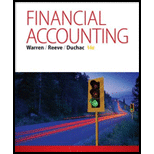
Concept explainers
(a)
Determine the amount of depreciation for four years ending December 31 by straight-line method.
(a)
Explanation of Solution
Methods of Depreciation: Depreciation refers to the reduction in the monetary value of a fixed asset due to its wear and tear, or obsolescence. It is a method of distributing the cost of the fixed assets over its estimated useful life.
The three methods of depreciation are:
- Straight-line method: Under the straight-line method of depreciation, the same amount of depreciation is allocated every year over the estimated useful life of an asset.
- Units-of-activity method: In this method of depreciation, the amount of depreciation is charged based on the unit of production each year.
- Double-declining balance method (Accelerated method): In this method of depreciation, the diminishing value of the asset is taken into consideration for determining the depreciation for the succeeding years.
Determine the amount of depreciation for four years ending December 31 by straight-line method.
2014:
Cost of the equipment= $108,000
Residual value of the equipment = $7,200
Estimated Useful life of the equipment = 3 years
Number of months equipment used =3 months (October 1-December 31)
2015:
Cost of the equipment= $108,000
Residual value of the equipment = $7,200
Estimated Useful life of the equipment = 3 years
Number of months equipment used =12 months (January 1-Deccember 31)
2016:
Cost of the equipment= $108,000
Residual value of the equipment = $7,200
Estimated Useful life of the equipment = 3 years
Number of months equipment used =12 months (January 1-Deccember 31)
2017:
Cost of the equipment= $108,000
Residual value of the equipment = $7,200
Estimated Useful life of the equipment = 3 years
Number of months equipment used =9 months (January 1-September 30)
Therefore, the amount of depreciation ending December 31 by straight-line method for 2014 is $8,400, 2015: $33,600, 2016: $33,600, and 2017: $25,200.
(b)
Determine the amount of depreciation for four years ending December 31 by units-of-activity method.
(b)
Explanation of Solution
Determine the amount of depreciation for four years ending December 31 by units-of-activity method.
| Year | Number of Hours (A) | Depreciation Expense (A×B) | |
| 2014 | 1,350 | $8.40 | $11,340 |
| 2015 | 4,200 | $8.40 | $35,280 |
| 2016 | 3,650 | $8.40 | $30,660 |
| 2017 | 2,800 | $8.40 | $23,520 |
Table (1)
Working note (1):
Determine the depreciable rate of the equipment.
Cost of the equipment= $108,000
Residual value of the equipment = $7,200
Estimated Useful life of the equipment = 12,000 operating hours.
Therefore, the amounts of depreciation for three years ending December 31 by units-of-activity method are 2014: $11,340, 2015: $35,280, 2016: $30,660, and 2017: $23,520.
(c)
Determine the amount of depreciation for four years ending December 31 by double-declining-balance method.
(c)
Explanation of Solution
Determine the amount of depreciation for four years ending December 31 by double-declining-balance method.
2014:
Cost of the equipment= $108,000
Estimated Useful life of the equipment = 3 years
Number of months equipment used =3 months (October 1-December 31)
2015:
Cost of the equipment= $108,000
Estimated Useful life of the equipment = 3 years
Number of months equipment used =12 months (January 1-December 31)
2016:
Cost of the equipment= $108,000
Accumulated Depreciation=
Estimated Useful life of the equipment = 3 years
Number of months equipment used =12 months (January 1-December 31)
2017:
Notes:
Accumulated depreciation is the sum total of the previous years’ depreciation expense.
The depreciation expense should not exceed the residual value of $7,200. Thus, it should be adjusted to make the book value of the equipment (cost less accumulated depreciation) equal to its residual value. Thus, the depreciation expense for 2017 would be
Therefore, the amounts of depreciation for four years ending December 31 by double-declining-balance method are 2014: $18,000, 2015: $60,000, 2016: $20,000, and 2017: $2,800.
Want to see more full solutions like this?
Chapter 10 Solutions
Financial Accounting
- I need guidance with this financial accounting problem using the right financial principles.arrow_forwardPlease explain the solution to this general accounting problem using the correct accounting principles.arrow_forwardWhat is the direct labor price (rate) variance? Accounting questionarrow_forward
- Solve with explanation and accounting questionarrow_forwardMatsuno Technology, Inc. sells market research reports for Asian markets. Its credit terms are 3/10, net 45. Based on experience, 70 percent of all customers will take the discount. What is the average collection period? (Do not round intermediate calculations)arrow_forwardCan you help me solve this general accounting problem with the correct methodology?arrow_forward
- Principles of Accounting Volume 1AccountingISBN:9781947172685Author:OpenStaxPublisher:OpenStax College
 Intermediate Accounting: Reporting And AnalysisAccountingISBN:9781337788281Author:James M. Wahlen, Jefferson P. Jones, Donald PagachPublisher:Cengage Learning
Intermediate Accounting: Reporting And AnalysisAccountingISBN:9781337788281Author:James M. Wahlen, Jefferson P. Jones, Donald PagachPublisher:Cengage Learning  College Accounting, Chapters 1-27AccountingISBN:9781337794756Author:HEINTZ, James A.Publisher:Cengage Learning,
College Accounting, Chapters 1-27AccountingISBN:9781337794756Author:HEINTZ, James A.Publisher:Cengage Learning, EBK CONTEMPORARY FINANCIAL MANAGEMENTFinanceISBN:9781337514835Author:MOYERPublisher:CENGAGE LEARNING - CONSIGNMENT
EBK CONTEMPORARY FINANCIAL MANAGEMENTFinanceISBN:9781337514835Author:MOYERPublisher:CENGAGE LEARNING - CONSIGNMENT Financial Accounting: The Impact on Decision Make...AccountingISBN:9781305654174Author:Gary A. Porter, Curtis L. NortonPublisher:Cengage Learning
Financial Accounting: The Impact on Decision Make...AccountingISBN:9781305654174Author:Gary A. Porter, Curtis L. NortonPublisher:Cengage Learning





